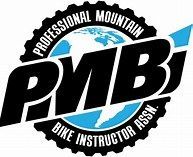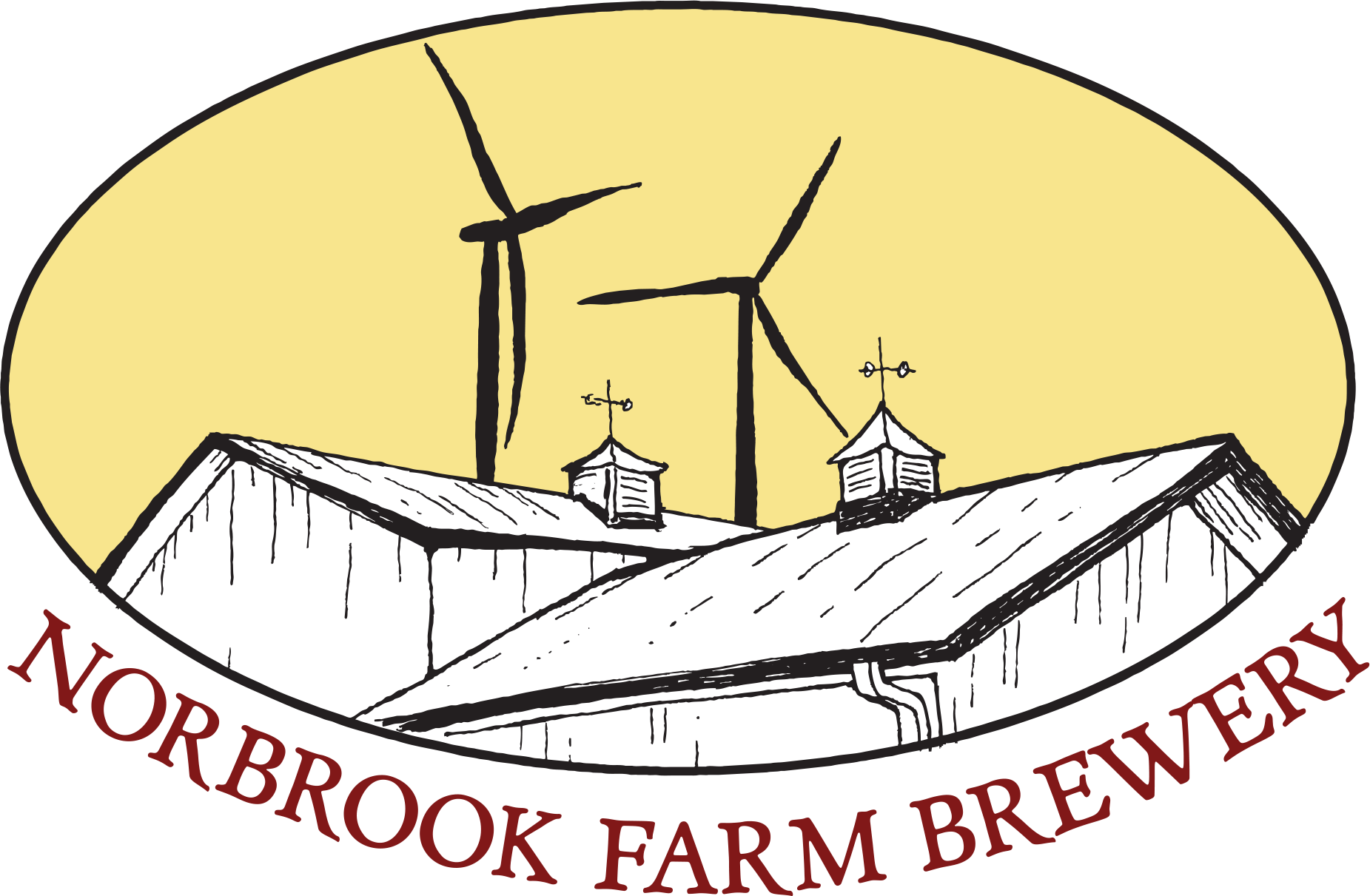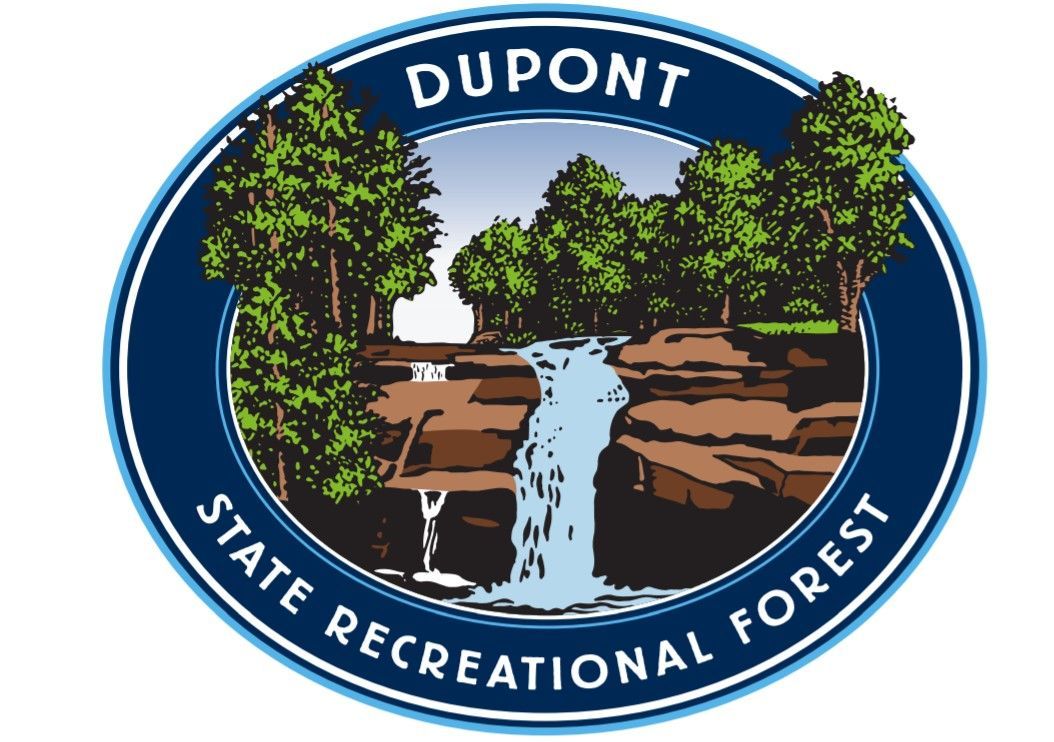Our BLOG is here to help you become a better rider so you can have better rides!
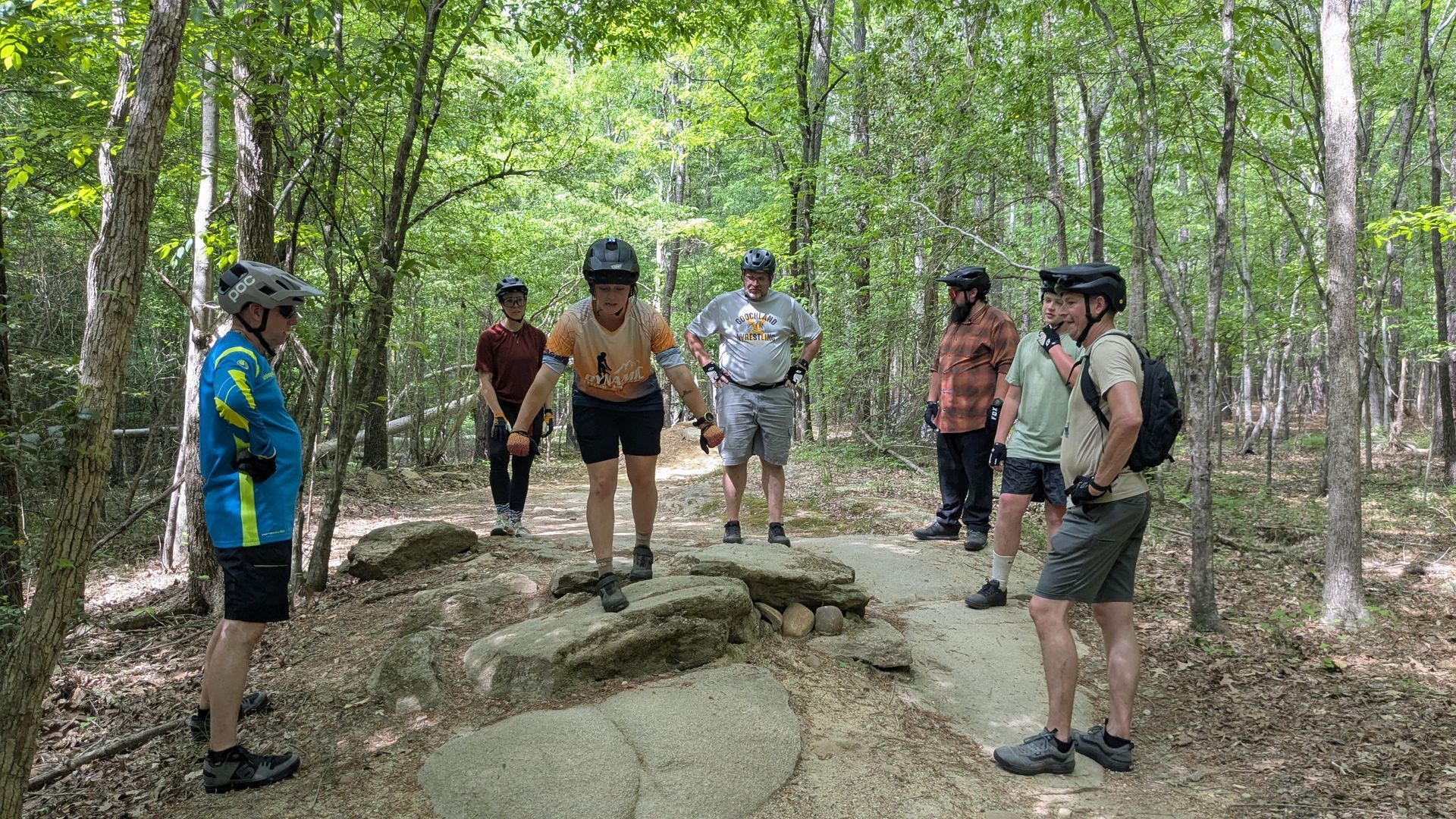
Not all Skills Companies are created equal….. I recognize this blog is self-serving but hear me out. Take five minutes to read what I have to say and then you make the decision if all mountain bike skills companies are created equal. There are all different types of skills companies out there from bigger companies who are in the industry full-time to small one-person companies who coach as a side hustle. I AM NOT SUGGESTING ANY OTHER COACHES ARE GOOD OR BAD. That is not what this blog is about. But there is a difference in the type of experience. So, what are the differences? Let’s start with the product, the clinic or camp and what skills you will learn. Companies that are in this space full-time are continuously investing resources ensuring riders are receiving the latest coaching and teaching techniques. From having employees that sit on the boards/curriculum development committees of organizations that train coaches to having those instructor trainers on staff offering multiple mandatory development weekends per year. Think of it this way, you may have a buddy that received a degree in accounting. They/them may work in an accounting field, mergers and acquisitions for example. That individual may even file their own taxes. But that doesn’t mean they have as much knowledge as a CPA about doing taxes. Your buddy doesn’t do it full time; they are not immersed in it. However, because its mountain biking it is not taken as seriously as other industries, but it’s the same principle. There is also this perception that larger companies utilize coaches from other areas. Many participants want to work with a ‘local coach’. Most of the larger organizations utilize local coaches. I worked for a few organizations before starting DCA and I was hired to run clinics in the area where I lived. That’s local. Again, I think because it’s mountain biking there is a misconception. Let’s use the example of a financial advisor, if you use a Merril Lynch person that lives in your town is that local? They work for a national firm, yet they live in your backyard. Same principle. I have heard that bigger companies are more expensive. I don’t know how true this is. I do know in our area there is a coach charging $350 for three hours. That is $100 more than our full eight-hour clinic and 45% percent higher than taking a private with DCA. On the flip side I know of a non-profit whose mission is to promote trail advocacy that has decided to move into the skills coaching industry. They are charging $50 dollar p/hour. The non-profit is certifying coaches to teach advanced maneuvers in three hours. Larger companies require a 3 DAY certification for level 1 and another 4 DAY certification for an advanced certification. So pricing is all over the board. Pricing is correlated to perceived value. When buying a bike customers do a ton of research and buy the bike they believe will provide them with the best ride. Do the same thing with coaching. Research the company or coach and make sure you are getting the kind of value you want for the money you are spending. How do you do the research? I can only tell you what our clients tell us they did, they read the reviews, spoke to riding buddies, called me directly, saw the results while riding with an alumnus or saw us at a venue and rode over to investigate. One final point about working with a company immersed full-time in the mountain biking skills industry is the culture and community. I am not suggesting that smaller companies do not have a great culture or solid community, I am sure they do. But I am going to use Ladies All Ride (LAR) as an example. LAR does an amazing job of promoting a community of women cyclists. They have the resources, staff and experience to provide a ‘festival’ like atmosphere for their participants. The participants become like groupies going to several events throughout the year. DCA firmly believes that community is one of the main factors that makes our sport unique (and pretty awesome). Being in the industry full time we areconstantly trying to do things that grow the community including DCA alumni weekends and adventure trips. As well as building relationships with vendors that provide special industry pricing to our community. We meet people at bike shops to provide guidance, DCA has the resources to continuously grow and support the community. Yeti bikes call it the YETI TRIBE, and they have gatherings, LAR has ‘groupies’, DCA has our alumni. All are doing the same thing cultivating a culture within the mountain bike community. I could go on but my five minutes is up. I am sure some of you have some thoughts so fire away. Hit me up at Patrick@dynamiccyclingadventures.com. Thank you for giving me five minutes. Now go ride or register for one of our clinics or Next Level Camps at www.dynamiccyclingadventures.com. Cheers, Patrick
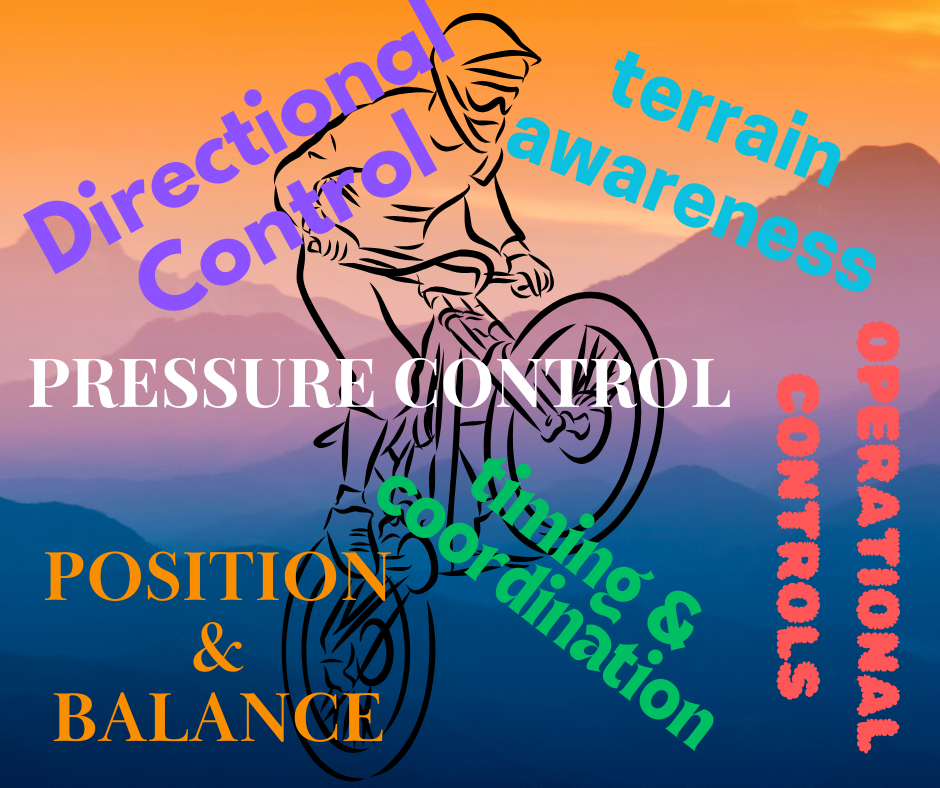
‘These are a few of my favorite things ‘ …..SKILLS With our apologies to Julie Andrews. Yes, we are dating ourselves paraphrasing Julie Andrews. However, today’s blog is all about our FAVORITE SKILLS. But first let’s define a skill. Websters says “ Skill is the ability to do something well , arising from talent, training, or practice . In the world of mountain biking, we use skills to successfully perform maneuvers. For example, cornering is a maneuver that requires six skills (take a clinic or camp to learn the skills required to corner like a pro). Some of those same skills overlap into DH riding. It’s more efficient to practice the skill so we can apply it to multiple maneuvers and various types of terrain. Rather than just learning to ‘jump’ let’s dial in pressure control so we can learn to properly use our suspension when we are riding as well as jumping. So, learn and practice the skills to develop muscle memory so we can DO SOMETHING WELL. Our professional coaches all have different favorite skills. Coach Lilly down in N.C. says “my two favorite skills are pumping because it is so useful for generating speed and staying in control of the bike and trail scanning because you can figure out proper body position, line choice and speed for the next section of trail by looking ahead. Coach Dale, over in Maine loves to be poppy and playful on the trail so his two favorite skills are timing/coordination and terrain awareness. Being able to read the trail to know where to pop and when to compress. Coach Glenn in CT enjoys exploring the skill of brake modulation as it relates to riding with flow and helping to ride faster (and safer). The main difference between an intermediate rider and an advance rider is the grasp of the Six Skills of Mountain Biking (yes there are only six skills). What we often see is a rider who wants to excel at a maneuver, jumping for example, will just focus on jumping. Instead of breaking down the maneuver to its individual skill(s). If you want to excel at certain features master the skills required prior to tackling the maneuver. You will have a greater chance of success. We all have a preference to what we enjoy riding. I prefer steep, gnarly tech (pro enduro lines). Some of our pro coaches prefer machine-built jump lines, while others prefer climbing. Whatever your favorite type of riding or features, one, some or all of the six skills are required to successful ride that type of terrain. We can call those “YOUR FAVORITE SKILLS”. Figure out you what you like to ride and send me an email at patrick@dynamiccyclingadventures.com . And I will let you know what your favorite skills should be! As always let me know your questions or comments. Cheers, Patrick
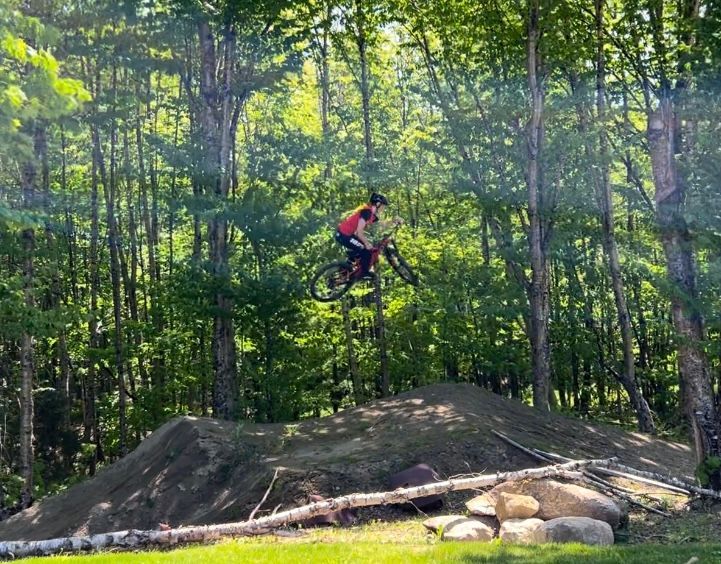
I CAN HIT THAT….. I think!! Confidence is fickle. Out riding one day and we feel we can conquer anything; no obstacle or feature is too big. Go out the next day and we fall or put a foot down riding over the smallest root or rock and suddenly we are in our head overthinking every feature. We have all been in this position. We look at the feature, we may have even ridden the feature, we know we have the skill set, we watch others do it…. but something in our head says no. Theodore Roosevelt said, “Believe you can your halfway there” and that is true. If you don’t BELIEVE YOU CAN then you shouldn’t try. Anyone who has taken a clinic or camp with me has heard me say “live to fight another day” (or “not today Satan”) meaning know when to bail if you are not feeling it. But how do we battle those negative thoughts that erode confidence?? Gymnasts call this the twisties. We all watched Simone Biles get the twisties in the 2020 Summer Olympics (and came back and absolutely crushed it 2024). When we as riders get the twisties the first thing we should do is go back and practice the Core Skills required to ride the feature or maneuver. Let’s say it’s a giant, steep rock roller, practice the right body position (take a clinic and camp if you are unsure), dial in your trail braking, think about where you are looking, and absorb at the transition. Start small, working your way back up to larger features. Even if you have already conquered the large feature, if your confidence is shot, progression is a great way to build it back up. It also allows you to continue dialing in the core skills. Utilize mental rehearsal (also called visualization). I prefer the term mental rehearsal as it reminds us that we are creating a detailed mental image of how we will successfully clean the feature. Again, using our rock roller example, imagine you’re starting at the top, visualize getting into the right position, see yourself modulating the brakes, tell yourself that if the back tire starts to skid you ease off the rear, visualize what will happen at the transition. There is an old saying “I will believe when I see it.” I think that’s backwards, it should be “I will see it when I believe it.” Going back to the Theodore Roosevelt quote, he said by believing you can your halfway there…the other half is having the skill. We can help you with the skill portion – register for a clinic or camp today. Let me know your questions or thoughts. Patrick
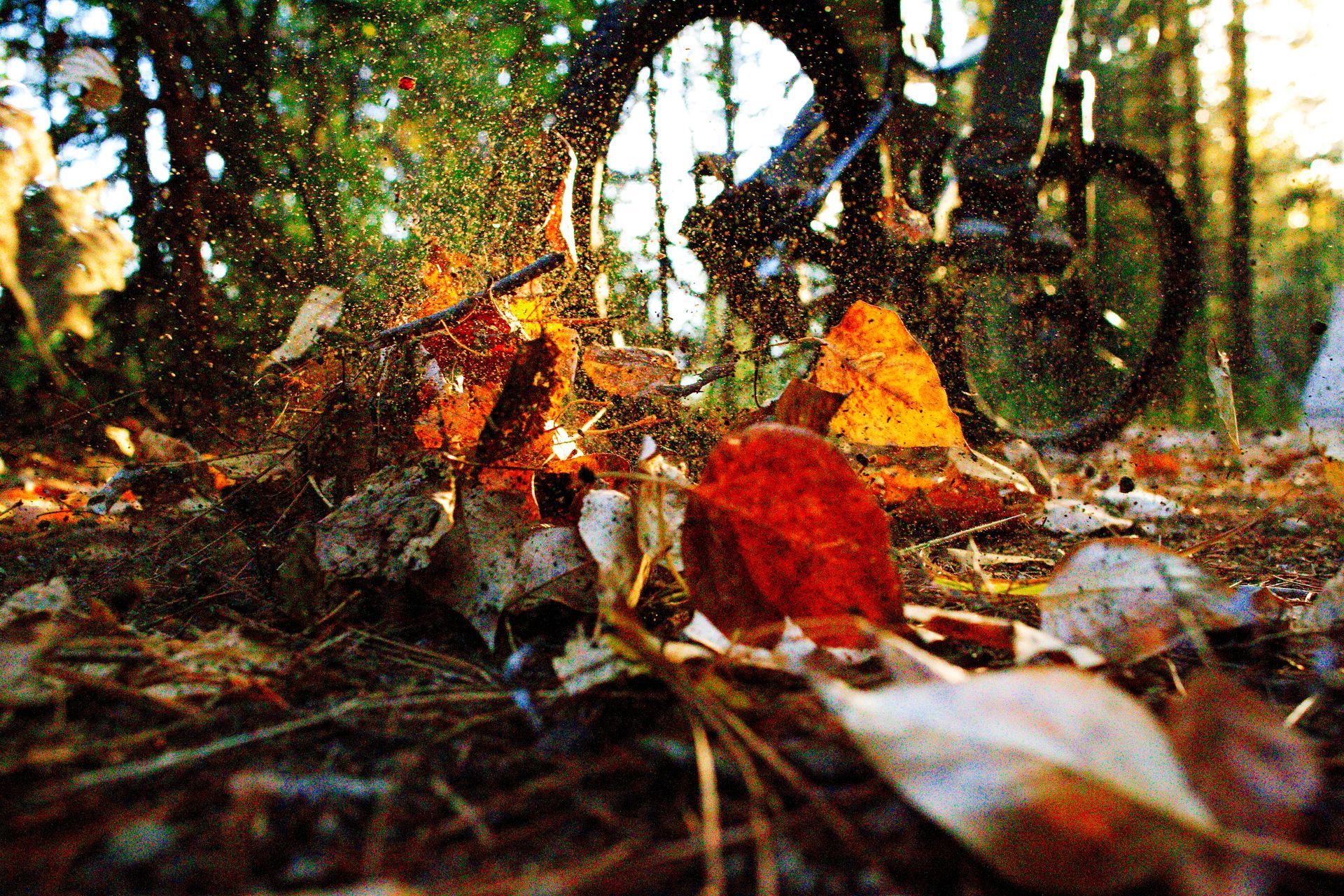
As the days grow shorter and the air turns crisp, nature transforms into a breathtaking canvas of vibrant colors. Autumn is not just a season; it's an experience that beckons outdoor enthusiasts to embrace its beauty. For mountain bikers, riding in fall leaves offers an exhilarating adventure that combines the thrill of cycling with the stunning backdrop of nature's palette. In this blog post, we’ll explore why mountain biking during this season is a must-do, tips for riding on a carpet of autumn leaves, and how to prepare for your fall biking escapade. The Allure of Fall Foliage Autumn is arguably one of the most beautiful times to be outdoors. The trees shed their summer greens for fiery reds, oranges, and yellows, creating a picturesque environment that enhances every ride. Mountain biking in these conditions allows riders to immerse themselves in nature while enjoying the crisp air and stunning views. The crunch of leaves beneath your tires adds an auditory layer to your ride that you won’t find in other seasons. Each pedal stroke sends you gliding over a colorful tapestry that feels almost magical. Whether you’re navigating through dense forests or winding trails, riding in fall leaves can transform an ordinary trail into an extraordinary adventure. Benefits of Mountain Biking in Autumn 1. Scenic Beauty One of the most significant advantages of mountain biking during autumn is undoubtedly the scenery. The vibrant foliage creates breathtaking landscapes that can make even familiar trails feel new again. Photographers and nature lovers alike flock to these areas to capture the beauty, but there’s nothing quite like experiencing it firsthand from your bike. 2. Ideal Riding Conditions Fall often brings cooler temperatures and less humidity compared to summer months, making it more comfortable for long rides. Additionally, many trails are less crowded during this time as families transition from summer activities back into their routines. This means more space for you to enjoy your ride without worrying about bumping into other cyclists or hikers. 3. Wildlife Activity Autumn is also a time when wildlife becomes more active as animals prepare for winter hibernation or migration. You may spot deer grazing on fallen acorns or squirrels gathering nuts—adding an element of excitement and unpredictability to your ride. Tips for Riding on Fall Leaves While mountain biking on a carpet of autumn leaves can be exhilarating, it does come with its own set of challenges. Here are some tips to ensure you have a safe and enjoyable experience: 1. Choose Your Trails Wisely Not all trails are created equal when it comes to riding in fall leaves. Look for well-maintained paths where fallen leaves won’t obscure rocks or roots that could cause accidents. Trails with moderate elevation changes are also ideal since they provide both challenge and enjoyment without being overly strenuous. 2. Adjust Your Riding Style Riding on loose surfaces like fallen leaves requires adjustments in technique compared to hard-packed dirt or gravel trails: Brake Early: Leaves can create slippery conditions; therefore, anticipate stops earlier than usual. Maintain Momentum: Keep your speed steady but controlled—too much speed can lead to loss of traction. Stay Loose: Keep your body relaxed and ready to react; this will help you maintain control over uneven surfaces. 3. Dress Appropriately Autumn weather can be unpredictable; layering is key! Start with moisture-wicking base layers and add insulating layers as needed while ensuring you have windproof outerwear if necessary. Don’t forget gloves and appropriate footwear—your hands will appreciate warmth when gripping handlebars! 4. Be Mindful of Visibility With shorter days ahead, plan your rides accordingly so you're not caught out after dark! Consider wearing bright colors or reflective gear so you're visible both on the trail and if you need assistance from others nearby. Preparing Your Bike for Fall Adventures Before heading out into those stunning autumn landscapes, ensure your bike is ready: Tires: Check tire pressure regularly; lower pressures may help improve grip on slippery surfaces. Brakes: Inspect brake pads since wet leaves can reduce stopping power significantly. Cleanliness: Remove any debris after each ride—leaves tend to accumulate dirt which could affect performance over time. Embrace the Season Mountain biking during autumn is not just about enjoying beautiful scenery—it’s about embracing all aspects that come with it: fresh air filled with earthy scents, vibrant colors surrounding you at every turn, wildlife sightings adding excitement along the way! So grab your bike gear and hit those trails covered by colorful carpets made up entirely from fallen foliage! Whether you're seeking solitude amidst nature's transformation or looking forward to sharing experiences with friends while navigating through piles upon piles of crunchy leaves—there's no better time than now! Get out there this fall season; let each pedal stroke remind you why mountain biking remains one of life's greatest pleasures!
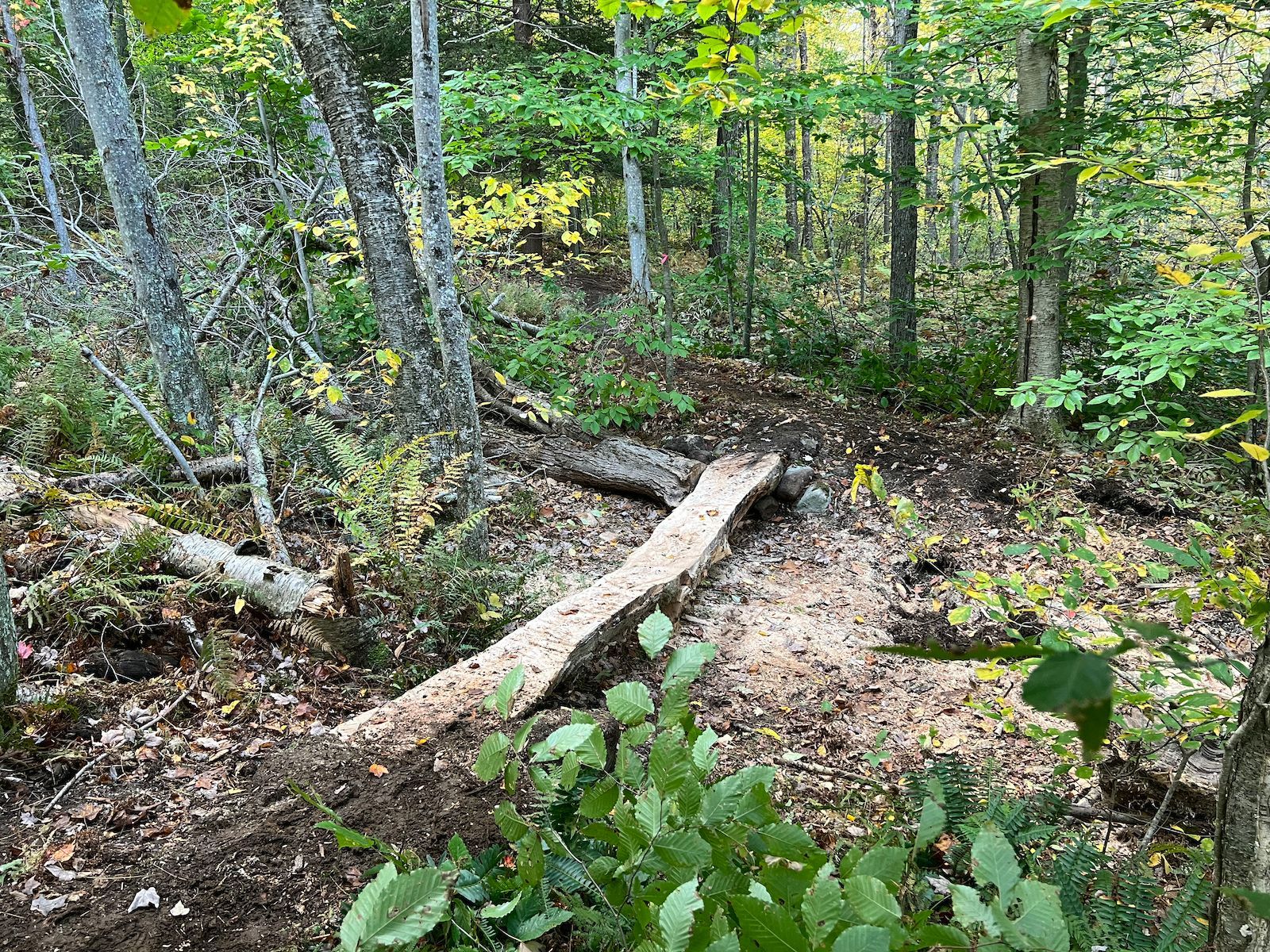
Nestled in the picturesque town of East Haddam, Connecticut, Nathan Hale-Ray Middle School is not just an educational institution but also a gateway to some of the most exciting mountain biking (MTB) trails in the region. Known as "The Playground Trails," these paths offer a unique blend of adventure, natural beauty, and exercise for both students and community members alike. In this blog post, we will explore what makes The Playground Trails at Nathan Hale-Ray Middle School a must-visit destination for mountain biking enthusiasts. A Brief History of Nathan Hale-Ray Middle School Nathan Hale-Ray Middle School has long been a cornerstone of education in East Haddam. Named after the famous American patriot Nathan Hale, the school has always emphasized not just academic excellence but also physical well-being. Over the years, it has developed various extracurricular activities that encourage students to engage with their environment actively. The Birth of The Playground Trails The idea for The Playground Trails was born out of a community initiative aimed at promoting outdoor activities among students and residents. With the help of local volunteers and school staff, these trails were meticulously planned and constructed to provide an engaging outdoor experience. Today, they serve as an excellent example of how schools can leverage their natural surroundings to benefit both education and community health. Trail Features and Layout Diverse Terrain One of the standout features of The Playground Trails is their diverse terrain. Whether you're a beginner or an experienced rider, you'll find something that suits your skill level. The trails wind through dense woods, open fields, and even some rocky areas that add an element of challenge. Well-Marked Paths Navigating through The Playground Trails is made easy with well-marked paths and clear signage. Each trail is color-coded based on its difficulty level—green for beginners, blue for intermediate riders, and black for advanced bikers. This system ensures that everyone can enjoy their ride without getting lost or venturing into areas beyond their skill level. Natural Beauty The trails are designed to showcase the natural beauty surrounding Nathan Hale-Ray Middle School. As you ride through these paths, you'll encounter stunning views of local flora and fauna. Seasonal changes bring different elements into focus—spring flowers bloom along the trail edges while autumn leaves create a colorful canopy overhead. Community Involvement Student Engagement One unique aspect of The Playground Trails is how they integrate into the school's curriculum. Physical education classes often include mountain biking sessions where students learn not just riding skills but also trail maintenance techniques. This hands-on approach helps instill a sense of responsibility towards nature among young learners. Volunteer Programs Community involvement doesn't end with students; parents and local residents frequently volunteer to maintain these trails. Regular clean-up drives ensure that the paths remain safe and enjoyable for everyone. These volunteer programs also foster a sense of community spirit and collective ownership over this valuable resource. Health Benefits Mountain biking offers numerous health benefits that make it an ideal activity for people of all ages: Cardiovascular Fitness : Riding on varied terrain helps improve heart health. Muscle Strength : Navigating through different types of paths strengthens various muscle groups. Mental Well-being : Being in nature has been shown to reduce stress levels significantly. Social Interaction : Group rides provide opportunities for socializing and building friendships. Given these benefits, it's no wonder that more people are flocking to The Playground Trails at Nathan Hale-Ray Middle School. How to Get There Nathan Hale-Ray Middle School is conveniently located off Route 151 in East Haddam. Ample parking is available near the school premises, making it easy for visitors to access The Playground Trails without any hassle. Safety Tips While mountain biking is generally safe when proper precautions are taken, it's essential to follow some basic safety guidelines: Wear Protective Gear : Always wear a helmet along with knee and elbow pads. Stay Hydrated : Carry enough water to stay hydrated throughout your ride. Know Your Limits : Stick to trails that match your skill level. Ride in Groups : Whenever possible, ride with others for added safety. Check Your Equipment : Ensure your bike is in good working condition before hitting the trails. Conclusion The Playground Trails at Nathan Hale-Ray Middle School offer more than just an exciting MTB experience; they represent a harmonious blend of education, community involvement, and natural beauty. Whether you're looking to introduce your children to mountain biking or seeking new adventures yourself, these trails provide an excellent opportunity to connect with nature while staying active. So why wait? Grab your bike and head over to Nathan Hale-Ray Middle School's Playground Trails today!
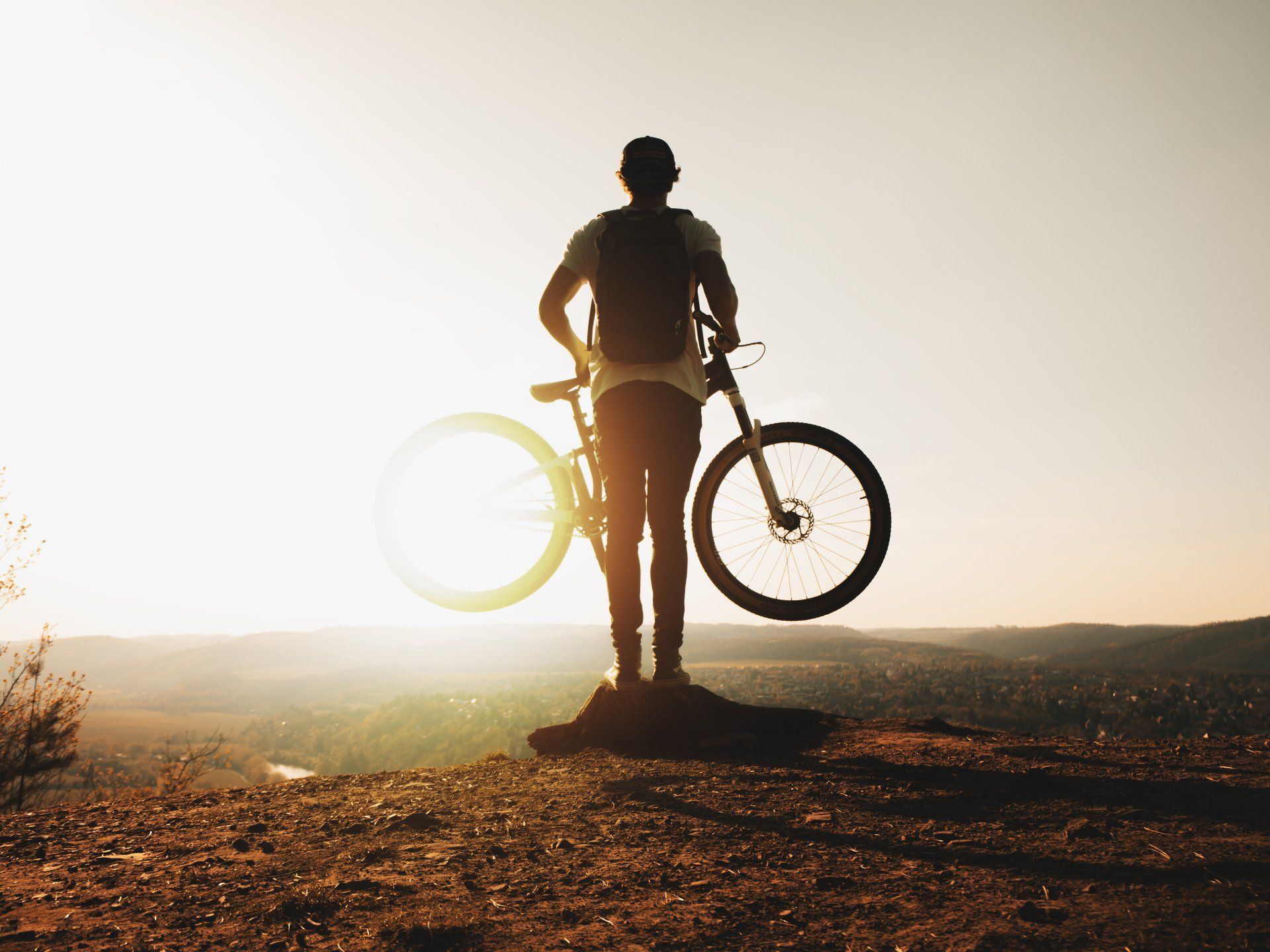
Why is Mountain Biking Addictive? Mountain biking has surged in popularity over the past few decades, captivating the hearts and minds of outdoor enthusiasts around the world. What is it about this sport that makes it so addictive? From the adrenaline rush to the sense of community, mountain biking offers a unique blend of physical, mental, and social benefits that keep people coming back for more. In this blog post, we'll delve into the various aspects that contribute to the addictive nature of mountain biking. The Adrenaline Rush One of the most compelling reasons why mountain biking is addictive is the sheer adrenaline rush it provides. Navigating through rugged terrains, steep descents, and sharp turns can be both thrilling and terrifying. This adrenaline surge triggers a release of endorphins—often referred to as "feel-good" hormones—which create a natural high. This euphoric feeling can be incredibly addictive, making riders crave their next adventure even more. The Challenge Mountain biking isn't just about coasting down hills; it's also about overcoming obstacles and pushing your limits. Whether it's mastering a difficult trail or conquering a steep climb, each challenge presents an opportunity for growth and improvement. The sense of accomplishment that comes from tackling these challenges can be highly rewarding and addictive. Connection with Nature Another reason why mountain biking is so addictive is its ability to connect riders with nature. Unlike road cycling or indoor spinning classes, mountain biking takes you off the beaten path and into some of the most beautiful landscapes imaginable. The fresh air, scenic views, and serene environment provide a much-needed escape from the hustle and bustle of everyday life. Mindfulness and Mental Health Being in nature has been proven to have numerous mental health benefits. Mountain biking requires focus and concentration, which can help clear your mind and reduce stress levels. This mindfulness aspect allows riders to be present in the moment, providing a form of meditation that many find incredibly therapeutic. Physical Fitness Mountain biking is an excellent full-body workout that combines cardiovascular exercise with strength training. The varied terrain requires constant adjustments in body position, engaging muscles in your legs, core, and upper body. This comprehensive workout not only improves physical fitness but also contributes to overall well-being. Weight Management For those looking to manage their weight or improve their fitness levels, mountain biking offers an effective solution. The combination of aerobic exercise (from pedaling) and anaerobic exercise (from navigating obstacles) helps burn calories efficiently. This makes it easier for riders to maintain or achieve their desired weight goals. Social Aspect The social component of mountain biking cannot be overlooked when discussing its addictive nature. Many people are drawn to the sport because it offers a sense of community and camaraderie among riders. Group Rides Group rides are a common feature in mountain biking communities. These rides provide an opportunity for individuals to share experiences, learn from one another, and build lasting friendships. The shared challenges and triumphs create strong bonds among riders, making each outing not just an adventure but also a social event. Competitions For those who thrive on competition, mountain biking offers numerous events ranging from local races to international competitions like cross-country marathons or downhill racing events. Competing against others—or even against oneself—adds another layer of excitement that keeps riders hooked on improving their skills. Technological Advancements The rapid advancements in bike technology have also contributed to making mountain biking more accessible and enjoyable than ever before. Better Equipment Modern bikes are lighter, more durable, and equipped with advanced suspension systems that make tackling rough terrains easier than ever before. These technological improvements enhance the overall riding experience by providing better control and comfort. Apps & Gadgets From GPS devices that track your route to apps that monitor your performance metrics like speed or heart rate—technology has made it easier for riders to set goals and measure progress accurately. This data-driven approach adds another layer of engagement that many find highly motivating. Conclusion: A Lifestyle Choice Ultimately, what makes mountain biking so addictive is its ability to offer something for everyone—whether you're seeking an adrenaline rush; looking for physical fitness; craving social interaction; or simply wanting some time alone in nature's embrace—mountain biking delivers on all fronts. It's not just a sport; it's a lifestyle choice—a way to challenge yourself physically while nurturing your mental well-being—a community where lifelong friendships are forged—and above all else—a never-ending adventure waiting around every corner. So if you haven't tried it yet—grab yourself some gear—and hit those trails—you might just find yourself getting hooked too!

As a mountain biker, you're always looking for ways to improve your skills and take your riding to the next level. One of the most impressive and useful techniques you can learn is the track stand. This skill allows you to balance on your bike without moving, making it easier to tackle technical trails and navigate tight turns. In this blog post, we'll guide you through the steps of mastering track stands on a mountain bike like a pro. What is a Track Stand? Before we delve into how to do it, let's first understand what a track stand is. A track stand is a technique used by cyclists where they balance on their bike at a complete stop without putting their feet on the ground. It's named after its origins in track cycling but has since become an essential skill for all types of biking, including mountain biking. Track stands on a mountain bike not only look cool but also offer practical benefits. They allow you to pause and plan your next move on technical trails without losing momentum or needing to dismount. Plus, they improve your overall balance and bike handling skills. The Basics of Track Stands Track standing may seem like an intimidating skill at first glance, but with practice and patience, anyone can master it. Here are some basic steps: 1. Find Flat Ground: Start practicing on flat ground before moving onto slopes or uneven terrain. 2. Position Your Feet: Your dominant foot should be forward (if you're right-handed, this will usually be your right foot). 3. Turn Your Front Wheel: Turn your front wheel towards your forward foot. 4. Balance: Try to maintain balance by shifting your weight back and forth slightly. Remember that practice makes perfect! Don't be discouraged if you can't hold the position for long at first – with time and repetition, you'll improve. Advanced Track Stand Techniques: Once you've mastered the basics, you can start experimenting with more advanced techniques. Here are a few to try: 1. Track Stand on a Slope:Th is is slightly easier than on flat ground because the slope provides natural resistance. Position your bike perpendicular to the slope and use the same technique as above. 2. Track Stand without Brakes: This requires more balance and control but will significantly improve your bike handling skills. 3. One-Handed or No-Handed Track Stands: These are challenging but impressive tricks to show off once you've mastered the basic track stand. Tips for Mastering Track Stands on a Mountain Bike Here are some additional tips to help you master track stands: 1. Start Small: Don't expect to hold a track stand for minutes at a time when starting out. Begin with aiming for just a few seconds, then gradually increase your time as your balance improves. 2. Use Your Hips: Your hips are key in maintaining balance during a track stand. Shift them side-to-side to help keep your balance. 3. Look Ahead: Don't look down at your wheels or the ground directly in front of you – this can throw off your balance. Instead, keep your gaze straight ahead. 4. Practice Regularly: Like any skill, the more you practice, the better you'll get. Mastering track stands on a mountain bike is an excellent way to enhance your biking skills and impress your friends on the trail. It may seem daunting at first, but with patience and practice, anyone can learn this cool trick. Remember that safety should always be your priority – always wear appropriate protective gear when practicing and riding, especially when trying new techniques like track stands. So why wait? Grab your mountain bike and start practicing today! With these tips and techniques in mind, you'll be track standing like a pro in no time.
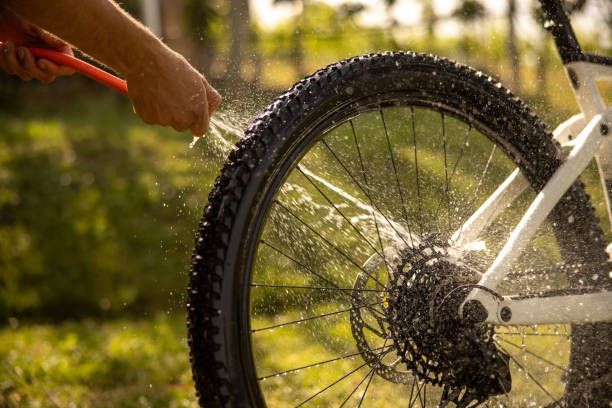
One of the most common questions that cyclists often ask is, "Is it okay to wash my bike with water?" The answer is yes, but there are a few caveats. Washing your bike regularly is a crucial part of bike maintenance. However, it's essential to avoid certain bike cleaning mistakes that could potentially damage your ride. In this blog post, we'll explore the best practices for washing your bike and highlight some common errors you should avoid. Understanding the Basics: Can You Wash Your Bike with Water? Yes, you can wash your bike with water. However, it's not as simple as hosing down your ride and calling it a day. There are specific methods you should follow to ensure that you're cleaning your bike without causing any harm. Firstly, avoid using a high-pressure hose or power washer. The force of the water can drive dirt and grime into areas where they shouldn't be, such as bearings and seals. This could lead to premature wear and tear on these components. Secondly, use warm soapy water instead of cold water. Warm water helps break down grime more effectively than cold water. Use a mild detergent or a specialized bike cleaner for the best results. Lastly, always dry your bike thoroughly after washing it. Leaving it wet can cause rusting and corrosion over time. Common Bike Cleaning Mistakes to Avoid 1) Using Harsh Chemicals One of the most common bike cleaning mistakes is using harsh chemicals or solvents to clean the frame or components. These substances can strip away lubricants from moving parts and degrade rubber seals over time. Instead of using harsh chemicals like bleach or ammonia-based cleaners, opt for mild soapy water or dedicated bicycle cleaners that are designed to be gentle on your ride while effectively removing dirt and grime. 2) Neglecting the Drivetrain The drivetrain, which includes the chain, cassette, and derailleurs, is a crucial part of your bike that often gets neglected during cleaning. A dirty drivetrain can affect your bike's performance and lead to premature wear and tear. Ensure you clean your drivetrain regularly using a chain cleaning device or a brush and soapy water. After cleaning, remember to lubricate the chain to keep it running smoothly. 3) Not Rinsing Properly Another common mistake is not rinsing the bike properly after washing. Soap residue can attract dirt and grime, leading to more frequent cleanings. Ensure you rinse off all soap thoroughly with clean water after washing. 4) Leaving the Bike Wet As mentioned earlier, leaving your bike wet after washing is a big no-no. Water can cause rusting and corrosion if left on the bike for extended periods. After rinsing, use a dry cloth or towel to wipe down your bike thoroughly. You can also leave it in the sun to dry completely. In conclusion, yes, it's okay to wash your bike with water as long as you do it correctly. Avoid common bike cleaning mistakes such as using harsh chemicals, neglecting the drivetrain, not rinsing properly, and leaving the bike wet after washing. Remember that regular maintenance goes beyond just cleaning – it includes checking tire pressure, tightening bolts and screws, lubricating moving parts, and replacing worn-out components when necessary. By following these tips and avoiding common mistakes in bike cleaning practices, you'll ensure that your ride stays in top shape for many miles ahead. Happy cycling


